Middle C is above the bass clef and below the treble clef; so together these two clefs cover much of the range of most voices and instruments.
The pitch of a note is how high or low it sounds. Pitch
depends on the frequency of the fundamental sound wave of the note. The higher
the frequency of a sound wave, and the shorter its wavelength, the higher its
pitch sounds. But musicians usually don't want to talk about wavelengths and
frequencies. Instead, they just give the different pitches different letter
names: A, B, C, D, E, F, and G. These seven letters name all the natural notes
(on a keyboard, that's all the white keys) within one octave. (When you get to
the eighth natural note, you start the next octave on another A.)
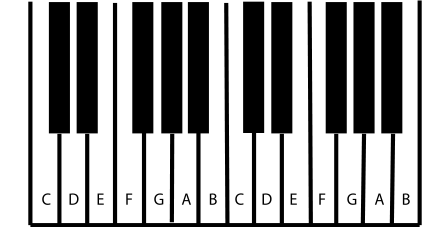
But in Western music there are twelve notes in each octave
that are in common use. How do you name the other five notes (on a keyboard,
the black keys)?
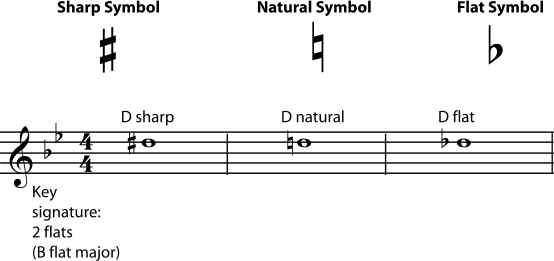
Sharp, flat, and natural signs can appear either in the key
signature, or right in front of the note that they change.
A sharp sign means "the note that is one half step
higher than the natural note". A flat sign means "the note that is
one half step lower than the natural note". Some of the natural notes are
only one half step apart, but most of them are a whole step apart. When they
are a whole step apart, the note in between them can only be named using a flat
or a sharp.
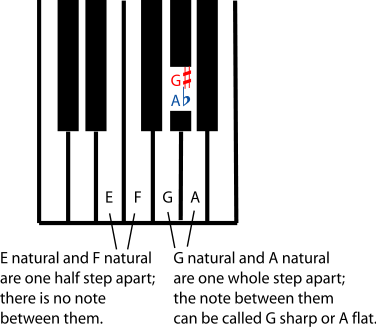
Notice that, using flats and sharps, any pitch can be given
more than one note name. For example, the G sharp and the A flat are played on
the same key on the keyboard; they sound the same. You can also name and write
the F natural as "E sharp"; F natural is the note that is a half step
higher than E natural, which is the definition of E sharp. Notes that have
different names but sound the same are called enharmonic notes.
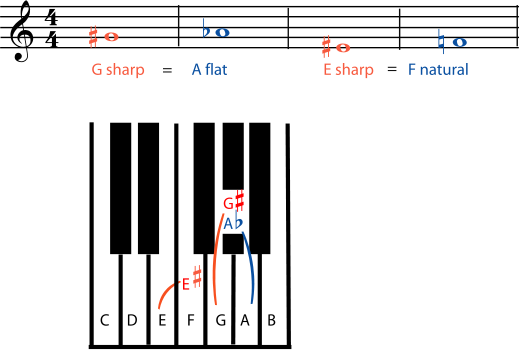
G sharp and A flat sound the same. E sharp and F natural
sound the same.
Sharp and flat signs can be used in two ways: they can be
part of a key signature, or they can mark accidentals. For example, if most of
the C's in a piece of music are going to be sharp, then a sharp sign is put in
the "C" space at the beginning of the staff, in the key signature. If
only a few of the C's are going to be sharp, then those C's are marked
individually with a sharp sign right in front of them. Pitches that are not in
the key signature are called accidentals.

When a sharp sign appears in the C space in the key
signature, all C's are sharp unless marked as accidentals.
A note can also be double sharp or double flat. A double
sharp is two half steps (one whole step) higher than the natural note; a double
flat is two half steps (a whole step) lower. Triple, quadruple, etc. sharps and
flats are rare, but follow the same pattern: every sharp or flat raises or lowers
the pitch one more half step.
Using double or triple sharps or flats may seem to be making
things more difficult than they need to be. Why not call the note "A
natural" instead of "G double sharp"? The answer is that,
although A natural and G double sharp are the same pitch, they don't have the
same function within a particular chord or a particular key. For musicians who
understand some music theory (and that includes most performers, not just
composers and music teachers), calling a note "G double sharp" gives
important and useful information about how that note functions in the chord and
in the progression of the harmony.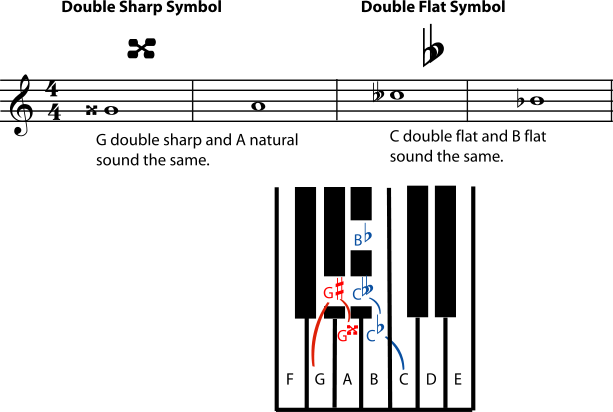

Double sharps raise the pitch by two half steps (one whole
step). Double flats lower the pitch by two half steps (one whole step).
Note
Do key signatures make music more complicated than it needs
to be? Is there an easier way? Join the discussion at Opening Measures.
The key signature comes right after the clef symbol on the
staff. It may have either some sharp symbols on particular lines or spaces, or
some flat symbols, again on particular lines or spaces. If there are no flats
or sharps listed after the clef symbol, then the key signature is "all
notes are natural".
In common notation, clef and key signature are the only
symbols that normally appear on every staff. They appear so often because they
are such important symbols; they tell you what note is on each line and space
of the staff. The clef tells you the letter name of the note (A, B, C, etc.),
and the key tells you whether the note is sharp, flat or natural.

The key signature is a list of all the
sharps and flats in the key that the music is
in. When a sharp (or flat) appears on a line or space in the key
signature, all the notes on that line or space are sharp (or flat), and all
other notes with the same letter names in other octaves are also sharp (or
flat).
Figure 1.26.

This key signature has a flat on the "B" line, so
all of these B's are flat.
The sharps or flats always appear in the same order in all
key signatures. This is the same order in which they are added as keys get
sharper or flatter. For example, if a key (G major or E minor) has only one
sharp, it will be F sharp, so F sharp is always the first sharp listed in a
sharp key signature. The keys that have two sharps (D major and B minor) have F
sharp and C sharp, so C sharp is always the second sharp in a key signature,
and so on. The order of sharps is: F sharp, C sharp, G sharp, D sharp,
A sharp, E sharp, B sharp. The order of flats is the reverse of the order of
sharps: B flat, E flat, A flat, D flat, G flat, C flat, F flat. So the
keys with only one flat (F major and D minor) have a B flat; the keys with two
flats (B flat major and G minor) have B flat and E flat; and so on. The order
of flats and sharps, like the order of the keys themselves, follows a circle of fifths.
Comments
Post a Comment